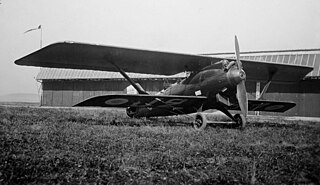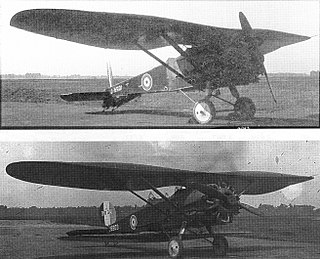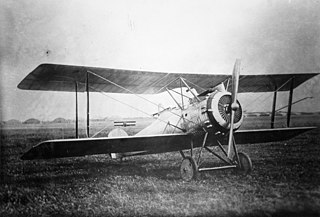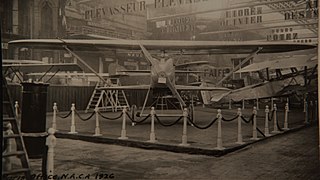
The Breguet 19 was a light bomber and reconnaissance aircraft, also used for long-distance flights, designed by the French Breguet company and produced from 1924.

The Nakajima E2N was a Japanese reconnaissance aircraft of the inter-war years. It was a single-engine, two-seat, sesquiplane seaplane with twin main floats.

The Bristol Bullfinch was an experimental British military aircraft first flown in 1922. Variants were built as both parasol wing monoplanes and biplanes, but both versions proved unsuccessful, and only the three prototypes were built.

The Gourdou-Leseurre GL-832 HY was a 1930s French light shipboard reconnaissance floatplane designed and built by Gourdou-Leseurre for the French Navy.
The Loening M-8 was a 1910s American fighter monoplane designed by Grover Loening and built by his Loening Aeronautical Engineering Company. An order of 5000 for the United States Army Air Corps was canceled when the First World War ended.

The Hanriot HD.3 C.2 was a two-seat fighter aircraft produced in France during World War I.

The Grigorovich M-11 was a Russian single-seat fighter flying boat designed by Dmitry Pavlovich Grigorovich and built by Shchetinin

The Short Type 827 was a 1910s British two-seat reconnaissance floatplane. It was also known as the Short Admiralty Type 827.

The Macchi M.5 was an Italian single-seat fighter flying boat designed and built by Nieuport-Macchi at Varese. It was extremely manoeuvrable and agile and matched the land-based aircraft it had to fight.

The Nieuport-Delage NiD 42 was a fighter aircraft built in France in the early 1920s, the first in a family of designs that would form the backbone of the French fighter force over the next decade.

The Loring R-III or R-3 was a 1920s Spanish two-seat sesquiplane reconnaissance and light attack aircraft designed by engineer Eduardo Barrón and built by Dr. Jorge Loring's company — Talleres Loring.

The Farman F.160 A.2 was a 1920s French sesquiplane designed as a military reconnaissance and observation aircraft. Only one was built.

The Bernard SIMB AB 14 was a 1920s French single-seat sesquiplane fighter aircraft designed and built by the Société Industrielle des Métaux et du Bois (SIMB). With a reluctance of the French authorities to purchase monoplanes the Bernard 14 was designed as a sesquiplane with Y-form struts bracing the wings on each side. It was powered by a Hispano-Suiza 12Hb inline piston engine and had a fixed tailskid landing gear. While on a test flight on 22 February 1926 the aircraft suffered a catastrophic structural failure of the upper wing and the only Bernard 14 was destroyed.
The Farman F.270 was a prototype French bomber/torpedo-bomber designed and built by the Farman Aviation Works for the French Air Force.

The Bernard 15 C1 or Bernard SIMB AB 15 was a 1920s French single-seat sesquiplane fighter aircraft designed and built by the Société Industrielle des Métaux et du Bois (SIMB). With the structural failure of the earlier Bernard 14 the Bernard 15 was an improved variant with a greater span upper wing. It was powered by a Hispano-Suiza 12Hb inline piston engine and had a fixed tailskid landing gear. The performance was not an improvement on the Bernard SIMB AB 14 and only the prototype was built.
The Borel-Odier Bo-T was a French twin-engined float biplane designed by Borel but built by Antoine Odier for the French Navy.

The Nieuport-Delage NiD 43 was a single engine, two seat biplane fighter aircraft designed and built for shipboard use in France in 1924.

The Wibault 12 Sirocco or Wib 12 Sirocco was a two-seat, parasol wing fighter aircraft designed and built in France in the 1920s. Three fighter prototypes were completed, one for the RAF and two Army co-operation variants. There was no series production.

The Levy Biche LB.2 was a single seat French sesquiplane fighter aircraft designed to be used from aircraft carriers. With a watertight fuselage, jettisonable wheeled undercarriage and small under-wing floats, it could survive emergency sea touchdowns; it could also be fitted with seaplane type floats.
The Kawanishi E13K, company designation AM-19, was a Japanese 1930s three-seat reconnaissance floatplane.
















